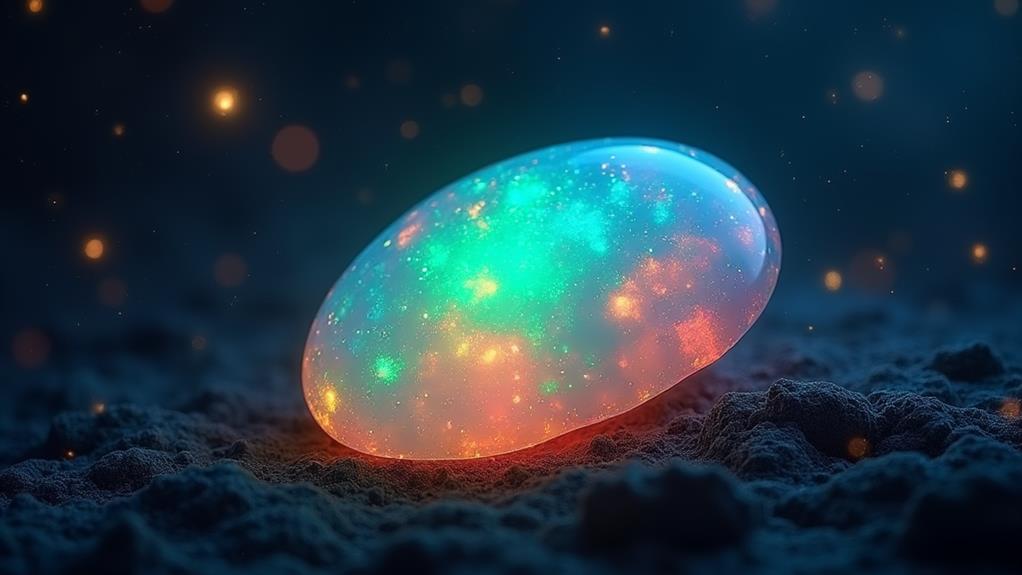Opal, a hydrated amorphous silica distinguished by its play-of-color, is esteemed for its rich symbolic meanings, healing properties, and zodiac benefits. Recognized as an October birthstone, it fosters love, hope, and emotional healing while enhancing intuition and spiritual clarity. This versatile crystal aligns with several chakras: pink opal with the Heart, yellow with the Solar Plexus, and black with the Root. Opal offers zodiac advantages, particularly for Cancer, Libra, Scorpio, and Pisces, by bolstering emotional depth and personal expression. Continue exploring to uncover the intricate ways opal influences emotional equilibrium and spiritual practices.
Key Takeaways
- Opal is the birthstone for October, symbolizing love, hope, and emotional depth.
- Enhances intuition, emotional healing, and spiritual well-being through its high vibrational frequency.
- Aligns with zodiac signs Cancer, Libra, Scorpio, and Pisces, promoting emotional balance and self-expression.
- Meditating with opal aids in releasing past traumas and enhances cosmic consciousness.
- Cleansing opal involves rinsing, smudging, or using a singing bowl, avoiding soaking due to its porous nature.
Crystal / Mineral Overview and Meaning
Opal, a hydrated amorphous form of silica, captivates with its unique play-of-color phenomenon, which results from the intricate diffraction of light through its internal structure of minuscule silica spheres. This optical marvel renders opal distinct among gemstones, offering a spectrum of vibrant flashes that range from fiery reds to serene blues. The complexity of its structure categorizes it into precious opal, known for its vivid displays, and common opal, which lacks the play-of-color and exhibits a milky or pearly appearance.
In addition to its visual allure, opal's significance extends into the domain of emotional and spiritual well-being. Recognized as the birthstone for October, opal is believed to embody the energies of love, hope, and emotional healing. This crystal has long been associated with the zodiac signs Cancer, Libra, Scorpio, and Pisces, further emphasizing its connection to emotional depth and intuition.
The healing properties of opal are intrinsically linked to its color variations, each correlating with specific chakras. Pink opal, for example, resonates with the Heart Chakra, promoting emotional balance and the healing of past traumas. Yellow opal, on the other hand, is connected to the Solar Plexus Chakra, enhancing personal power and self-confidence. These attributes underline opal's multifaceted role in emotional and spiritual health.
Historically, opal has been steeped in legend and superstition, often credited with enhancing intuition and psychic abilities. It is also thought to offer karmic protection and foster loyalty in relationships. Opal's rich tapestry of meanings and healing properties solidifies its standing as a gemstone of profound emotional resonance.
Healing and Spiritual Enhancements
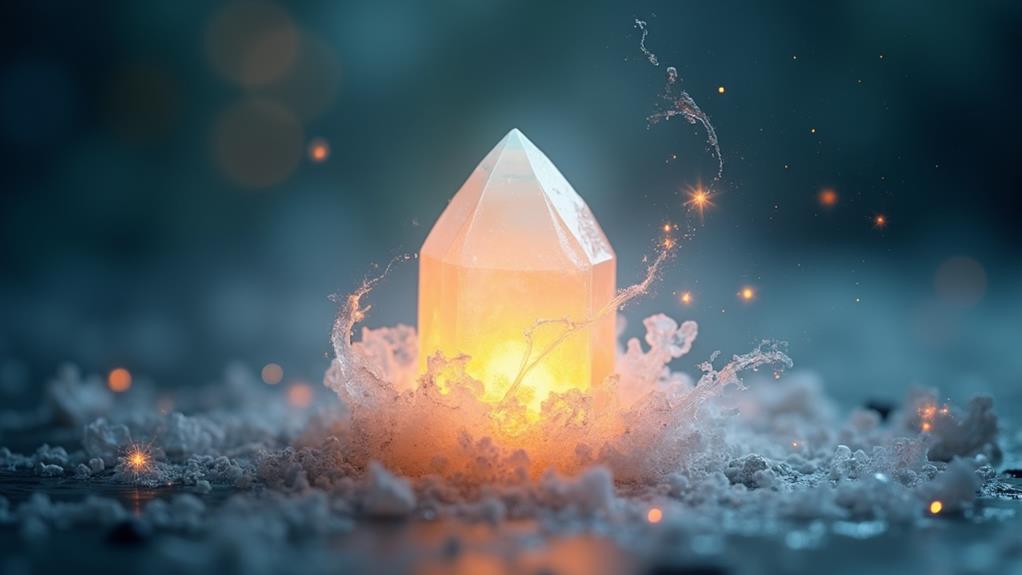
Nicknamed the 'Queen of Gems,' opal offers multifaceted benefits that enhance both physical and spiritual well-being. This gemstone's alignment with various chakras facilitates energy flow and balance, making it indispensable for meditation and spiritual practices. Proper cleansing techniques are essential to maintain its efficacy, ensuring that opal's full spectrum light energy consistently supports introspection, emotional stability, and psychic development.
Nicknamed the 'Queen of Gems
Often celebrated for its mesmerizing play of colors, the gemstone known as opal has earned the moniker 'Queen of Gems' due to its profound impact on both healing and spiritual practices. The opal meaning is deeply rooted in its historical significance as a symbol of hope, purity, and emotional healing. This precious opal is renowned for its ability to amplify emotions and enhance self-expression, thereby promoting creativity and supporting mental clarity.
The healing energies of opal extend beyond the emotional domain, offering physical benefits such as boosting the immune system, treating infections, and supporting skin health. Its multifaceted properties align with various chakras, particularly the Heart Chakra (Pink Opal) and the Solar Plexus Chakra (Yellow Opal), fostering emotional balance and spiritual growth.
In the sphere of spirituality, opal is revered for its connection to intuition and spiritual insight. Practitioners frequently incorporate this gemstone into meditation practices to facilitate deeper self-exploration and establish a connection with higher dimensions. This amplifies the stone's role in enhancing one's spiritual journey, making it an essential tool for those seeking profound personal transformation through holistic means. The opal's unique interplay of colors and energies unequivocally positions it as the 'Queen of Gems.'
The "Queen of Gems" Benefits
The myriad benefits of the opal, revered as the "Queen of Gems," extend across both healing and spiritual domains, rendering it an invaluable asset in holistic practices. Opal Healing is renowned for its capacity to enhance emotional intelligence, fostering an equilibrium that promotes balance and harmony within the wearer. This gemstone's unique play of color is not merely an aesthetic marvel but also a potent amplifier of thoughts and intentions, making it instrumental in manifestation practices and the elevation of creative energies. Additionally, opal is celebrated for its protective qualities, serving as a spiritual light that shields against negative energies while enhancing psychic abilities and intuition.
The stone's association with various chakras facilitates chakra alignment, promoting energetic healing and holistic well-being. This alignment is particularly beneficial during times of emotional upheaval, as opal assists in the release of old wounds, propelling positive transformation and supporting emotional healing.
- Emotional Healing: Facilitates the release of past traumas and supports positive change.
- Balance: Promotes harmony and equilibrium within the wearer.
- Spiritual Light: Acts as a protective shield during spiritual work.
- Chakra Alignment: Enhances energetic healing by aligning various chakras.
Incorporating opal into your holistic practices can consequently yield profound benefits across emotional, physical, and spiritual dimensions.
Meditation With Opal Crystals
Meditating with opal crystals can greatly enhance one's cosmic consciousness and intuition, yielding profound insights and deep spiritual connections during sessions. The opal's unique play of color acts as a prism for the mind, amplifying thoughts and facilitating transformative self-examination. This dynamic interaction between light and crystal structure makes opal an invaluable tool in meditation practices.
Each variety of opal resonates with specific chakras, thereby aligning and optimizing energy flow. For instance, Black Opal influences the Root Chakra, grounding practitioners and fostering stability, while Blue Opal activates the Throat Chakra, enhancing communication and expression. The alignment of these chakras during meditation sessions contributes considerably to both spiritual and emotional balance.
Furthermore, opal is esteemed for its ability to promote emotional equilibrium. It aids in the release of past traumas, creating a serene environment conducive to meditative states. The incorporation of opal in meditation also attracts angelic energies, facilitating divine communication and enriching the spiritual experience. By fostering a tranquil and balanced emotional landscape, opal enhances the meditative journey, making it a profound tool for spiritual growth and emotional healing.
How to Cleanse Opal Crystals
Proper cleansing of opal crystals is vital to maintain their healing and spiritual properties. Given the porous nature of opals, it is important to handle them with care during the cleansing process. To cleanse, gently rinse the opal under lukewarm running water for a few moments, taking care not to soak the stone for extended periods to prevent water damage. This method helps to wash away superficial impurities without compromising the opal's integrity.
For a more profound cleansing, smudging with sage or palo santo is highly effective. The smoke from these sacred herbs can purify the opal, removing any negative energies accumulated during use. Additionally, employing a singing bowl around the opal introduces vibrational frequencies that cleanse and revitalize the stone without physical contact, preserving its delicate structure.
Charging opals by placing them in sunlight or moonlight for a few hours enhances their energetic properties and vibrancy. However, it is crucial to avoid saltwater and extreme temperatures, as these conditions can irreparably damage the crystal. By adhering to these meticulous methods, one can guarantee that opals remain potent tools for healing and spiritual enhancement.
Amethyst Synergy With Opal
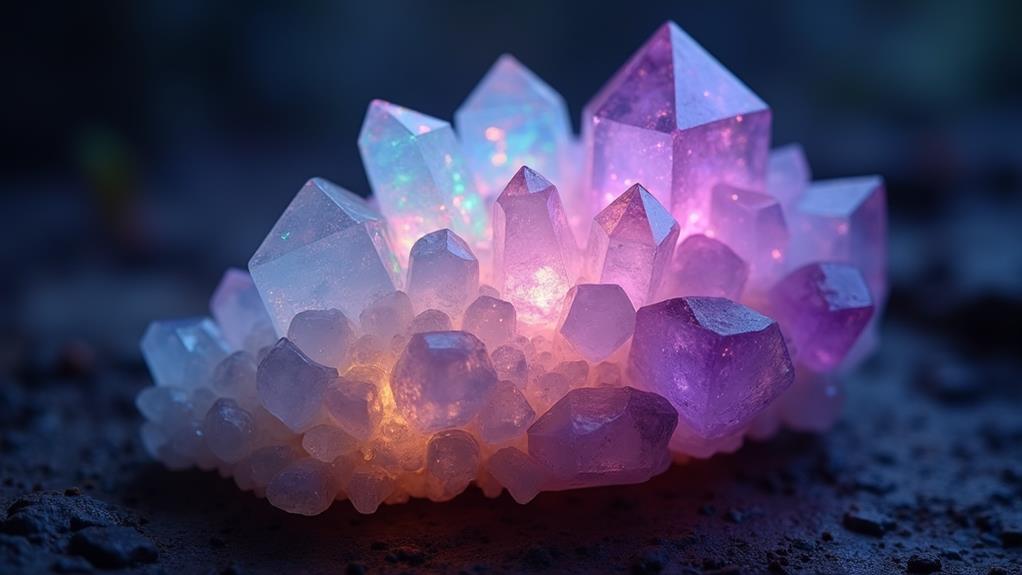
The synergy between amethyst and opal presents a compelling combination for those seeking enhanced emotional and spiritual well-being. The healing properties of amethyst, renowned for its calming and protective qualities, complement and uplift the vibrant energies of opal. This pairing is particularly effective in promoting emotional balance and clarity during introspection and self-discovery.
Amethyst's ability to foster tranquility aids in amplifying opal's capacity to release past wounds and dissolve emotional blockages. This dynamic interaction facilitates a deeper connection to one's spiritual self, enabling a more profound exploration of inner landscapes. Such synergy supports the enhancement of intuition and psychic abilities, as both stones are intrinsically linked to higher domains of consciousness.
Opal, with its unique energy, when paired with the soothing properties of amethyst, creates a harmonious balance that not only stabilizes emotions but also encourages creativity and emotional expression. This blend is particularly beneficial during meditation practices, where the combined energies of these stones can deepen spiritual insights and amplify manifestation intentions. The complementary nature of amethyst and opal can therefore be a powerful tool for those engaging in spiritual practices or seeking overall well-being.
Astrological Significance

Opal, the birthstone for October, holds particular astrological significance for individuals born under the zodiac signs of Libra and Scorpio, enhancing their intrinsic qualities of harmony and emotional depth. This gemstone's association with the Water element underscores its capacity to elevate intuition, sensitivity, and emotional fluidity. Additionally, the numerical vibration of opal aligns with the number 8, symbolizing balance and power, which can particularly benefit Libras seeking equilibrium and Scorpios aiming to navigate emotional challenges and jealousy.
Astrological Compatibility With Opal
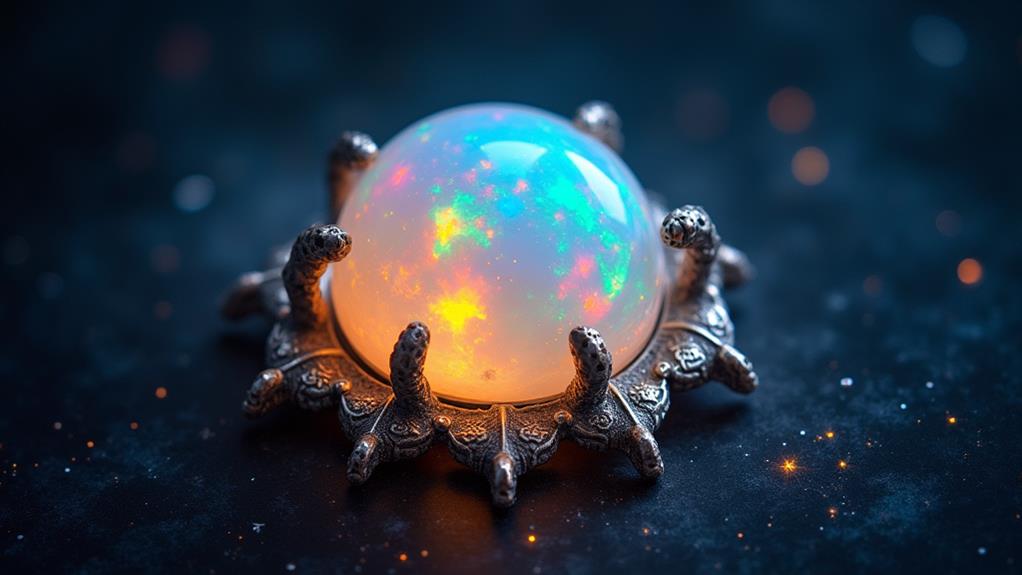
Although widely celebrated for its aesthetic allure, the opal's astrological significance extends far beyond its visual appeal. Particularly beneficial for individuals born under the signs of Libra and Scorpio, the opal enhances their inherent qualities through its unique energetic properties. For Libras, this gemstone promotes harmony and balance, aligning seamlessly with their intrinsic desire for peace and meaningful relationships. In contrast, Scorpios find solace in opal's ability to support emotional healing and transformation, aiding them in traversing their intense emotional landscapes.
The opal is intricately associated with the element of Water, resonating deeply with the emotional depth and intuitive nature of both Libra and Scorpio. This connection further amplifies the gemstone's influence on these zodiac signs, fostering a profound sense of emotional equilibrium and intuitive insight. The opal's energetic properties are also linked to the crown chakra, facilitating spiritual growth and enhancing psychic abilities, particularly advantageous for water signs like Scorpio.
Wearing opal jewelry, such as rings or necklaces, can considerably amplify the positive traits of Libras and Scorpios. This practice aids them in overcoming emotional challenges while fostering self-expression, making the opal an indispensable ally in their astrological journey.
Opal Birthstone Significance

Recognized as the birthstone for October, opal holds significant astrological importance, symbolizing hope, purity, and emotional healing. Opal's unique vibrational energy aligns with the number 8, a numeral synonymous with balance and power, enhancing the stone's intrinsic properties. As a birthstone, opal is particularly significant for individuals born under the zodiac signs of Libra and Scorpio. For Libras, opal aids in achieving emotional stability and equilibrium, aligning perfectly with their inherent need for balance. In the context of Scorpio, opal helps mitigate emotional inconsistencies and jealousy, promoting deeper emotional healing and resilience.
The healing properties of opal extend beyond mere emotional regulation. Its association with the Water element emphasizes a profound connection to emotions and intuition, fostering self-acceptance and creativity. This elemental linkage underscores the opal's ability to amplify the energies of October-born individuals, enhancing their creative faculties and emotional depth. The play of color within opal not only provides aesthetic beauty but also symbolizes the multifaceted nature of human emotions and experiences, making it a potent tool for emotional healing.
Elemental Associations With Opal
In the domain of astrological significance, the elemental associations of opal are paramount in understanding its influence on emotional and intuitive faculties. Opal, with its intrinsic connection to Water energy, embodies the fluidity and depth of emotions, intuition, and personal expression. This element, symbolizing adaptability and emotional flow, aligns perfectly with the opal's physical and metaphysical properties.
As the birthstone for October, opal holds particular relevance for Libras and Scorpios. Libras, ruled by Venus, find opal instrumental in fostering harmony and balance within their relationships and surroundings. The opal's Water energy helps soothe the emotional body, promoting peace and equilibrium. For Scorpios, governed by the transformative power of Pluto, opal serves as a conduit for overcoming emotional challenges and jealousy, facilitating deeper emotional connections and self-awareness.
Moreover, opal's vibrant play of color resonates with various chakras, especially enhancing the Heart Chakra. This amplification of spiritual energy aids in personal growth and emotional healing, allowing for a more balanced emotional state. By harmonizing these energies, opal stands as a versatile crystal, fostering emotional resilience and intuitive clarity for those who embrace its profound elemental associations.
Opal in Ancient Cultures

Opal has been revered across various cultures, particularly in ancient Rome where it symbolized hope and purity, as described by Pliny the Elder. Additionally, Queen Victoria amassed a significant opal collection, reflecting the gemstone's enduring appeal and historical significance. Queen Elizabeth's opal brooch further underscores the stone's esteemed position in royal artifacts, linking it to both historical and contemporary cultural narratives.
Queen Victoria's Opal Collection
Queen Victoria's opal collection, a dazzling array of gemstones, played a pivotal role in the resurgence of opal's popularity during the 19th century. Her affinity for opal jewelry, adorned with the gemstone's unique play-of-color, helped elevate its status to a symbol of elegance and sophistication. By gifting opal pieces to her family and friends, Queen Victoria not only sparked a fashion trend across Europe but also rekindled an appreciation for a stone long revered in ancient cultures.
Historically, opal was considered a stone of protection, believed to enhance intuition and spiritual insight. Ancient civilizations, including the Greeks and Romans, held the opal in high regard, attributing mystical powers to its iridescent hues. This historical reverence contributed to the gemstone's allure during Queen Victoria's reign.
The opal collection owned by Queen Victoria was notable for its exquisite craftsmanship and vibrant colors, reflecting an era of opulent jewelry design. Her influence helped establish opal as the birthstone for October and a traditional gift for the 14th wedding anniversary, embedding its cultural significance. Consequently, her collection was instrumental in renewing the gemstone's charm and solidifying its place in modern jewelry.
Opal in Ancient Rome
The significance of opal in ancient Roman culture was profound, as it was esteemed not only for its aesthetic appeal but also for its symbolic attributes. Regarded as a precious stone, opal captivated Romans with its unique play of color, often described by Pliny the Elder as encapsulating the hues of garnet, amethyst, and emerald. This varied beauty made opal a coveted gem among Roman nobility, who prized it for its visual allure and deeper connotations.
Romans attributed protective qualities to opal, believing it could ward off negative energies and bring good luck. The gemstone was often associated with Fortuna, the goddess of luck and prosperity, further cementing its reputation as a talisman of positive energies. Wearing opal jewelry was thought to attract the favor of Fortuna, enhancing the wearer's fortune and safeguarding their wellbeing.
The term "opalus" in Latin reflects the gemstone's esteemed status in Roman society. Its symbolic representation of hope and purity added to its desirability, making opal a multifaceted treasure in ancient Rome. The reverence for opal during this period highlights its enduring legacy as a stone of both beauty and benevolent power.
Queen Elizabeth's Opal Brooch
While renowned for its aesthetic brilliance and historical significance, the opal brooch owned by Queen Elizabeth II encapsulates the deep-seated reverence for this gemstone across various ancient cultures. Gifted by her mother, this exquisite piece not only underscores opal's royal connections but also reflects its deeply rooted cultural and spiritual properties.
The opal's historical significance spans a multitude of ancient cultures. Early Romans revered it as a conglomerate of all gemstones, symbolizing purity and hope. In ancient Greece, opal was esteemed as a divine stone, believed to grant foresight. Medieval European societies trusted in its ability to bring good luck and ward off disease. The ancient Egyptians integrated opal into burial rituals, believing it offered protection in the afterlife. Indigenous cultures, too, have long valued opal for its spiritual properties, incorporating it into ceremonies aimed at enhancing intuition and spiritual connectivity.
| Ancient Culture | Belief or Use | Significance |
|---|---|---|
| Ancient Rome | Symbol of all gemstones | Purity and hope |
| Ancient Greece | Divine connection | Foresight |
| Medieval Europe | Protective talisman | Good luck and disease prevention |
| Ancient Egypt | Burial rituals | Safeguard in the afterlife |
This multifaceted historical context enriches the opal brooch's allure, intertwining royal connections with a tapestry of ancient cultural reverence.
Ancient Australian Aboriginal Legends
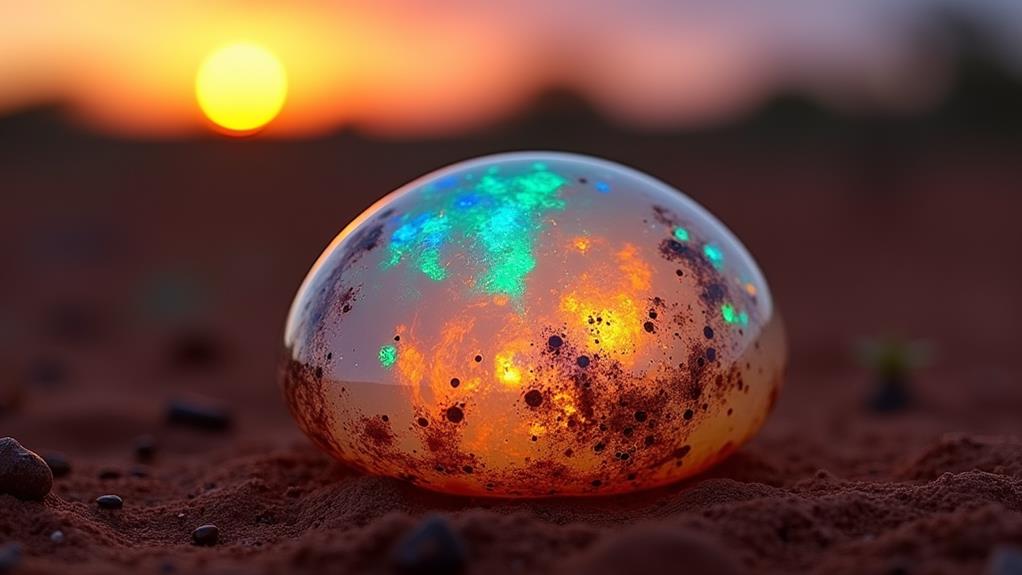
The ancient Australian Aboriginal legends surrounding opals are deeply interwoven with the mineral's geological formation and unique characteristics. Australian opal mines, renowned for their rich deposits of hydrated silica, produce specimens exhibiting a remarkable play-of-color, which Aboriginal people interpret as a manifestation of spiritual energy and natural beauty. These varying forms and patterns of opal not only reflect the mineral's intricate composition but also embody the profound cultural and spiritual significance attributed to it by ancient Aboriginal traditions.
Australian Opal Mines
Renowned for their unparalleled beauty and vibrant color play, the opal mines of Australia, particularly in Lightning Ridge and Coober Pedy, hold both historical and cultural significance. These Australian opal mines are famed for producing some of the world's finest opals, including the rare black opal, revered for its mesmerizing spectrum of colors. The opal fields were first discovered in the late 19th century, sparking a mining boom that profoundly impacted both the cultural and economic landscapes.
Ancient Australian Aboriginal legends imbue these opals with deep spiritual meaning. Often described as the tears of ancestors, these stones are believed to carry spiritual significance and symbolize hope and a profound connection to the land. Aboriginal stories also narrate that opals are remnants of a rainbow created by ancestral spirits, linking the stone to themes of creation and transformation.
The mining of these opals has had significant implications for Indigenous communities, integrating the stones into their cultural heritage. Australia now accounts for approximately 97% of the global opal supply, making these gems an essential element of both national pride and economic importance. Through their unparalleled beauty and deep-rooted cultural connections, Australian opals continue to captivate the world.
Hydrated Silica Mineral Composition
Opal's unique hydrated silica mineral composition is central to its enchanting play of color and striking visual appeal. Formed through the slow deposition of silica-rich waters, opal possesses a unique structure that enables its vibrant colors. This structure, a product of ancient volcanic activity, allows opal to retain up to 21% water content—a distinctive characteristic among gemstones that imparts an ethereal and almost otherworldly appearance.
Australian Aboriginal legends imbue opal with profound spiritual significance, viewing it as a divine gift from the Creator that encapsulates the essence of both the Earth and the sky. These legends are reflected in the vibrant colors and unique patterns of precious opal, which symbolize a deep connection to the land and the spiritual world.
- Water Content: Opal can contain up to 21% water, contributing to its unique structural and visual properties.
- Formation: Often linked to ancient volcanic activity, creating the conditions necessary for its unique structure.
- Global Supply: Australia is the predominant source, producing 97% of the world's precious opal.
- Spiritual Significance: Aboriginal legends associate opal with spiritual gifts from the Creator, embodying natural elements.
In essence, the hydrated silica mineral composition of opal is not just a geological marvel but also a cultural and spiritual symbol.
Opal's Iridescent Play-of-Color
Embedded within the intricate mineral composition of opal lies a phenomenon that captivates both geologists and cultural historians alike: the iridescent play-of-color. This unique optical effect is not only a marvel of hydrated silica but also a symbol deeply embedded in the lore of Ancient Australians. Aboriginal cultures regard opal as a divine gift from the Creator, imbued with the spirits of ancestors, thereby serving as a vital link between the physical and spiritual worlds.
According to ancient Aboriginal legends, the opal's iridescent play-of-color represents the presence of stars in the sky, offering guidance and protection. These stories often feature the Rainbow Serpent, a pivotal figure in Aboriginal mythology, whose journey across the land is believed to have created the opal's colorful patterns. This connection renders opal sacred within Aboriginal cultures, where it is utilized in rituals and ceremonies aimed at promoting healing and spiritual connection.
The gemstone's mesmerizing beauty has also found its way into various Aboriginal artworks, reflecting its cultural significance and the deep-rooted legends that surround it. Indeed, opal remains a powerful symbol of the enduring spiritual and cultural heritage of Ancient Australians.
Opal Forms and Patterns
The intricate forms and patterns of opal are imbued with profound cultural significance within Ancient Australian Aboriginal legends. These legends regard opal as a divine gift from the creator, symbolizing a deep connection between the earth and the sky. The gemstone's vibrant colors are seen as encapsulating various ancestral stories and spirits, consequently carrying immense spiritual significance.
According to these ancient narratives, opal is believed to be formed from the tears of ancestors, which solidified upon touching the earth, thereby embodying both spiritual and emotional healing. The Aboriginal people perceive opal as a protective stone, closely associated with the Rainbow Serpent—a central figure in their mythology that signifies creation and fertility. Different patterns and colors found within opal reflect unique tribal stories and characteristics, making each piece a cultural artifact rich in meaning.
Opal's unique play-of-color serves as a conduit for spiritual communication, enhancing its mystical status within Aboriginal traditions. This multifaceted gemstone continues to be revered for its:
- Spiritual significance: A bridge between the earthly and the divine.
- Protective qualities: Linked to the Rainbow Serpent.
- Cultural storytelling: Each pattern narrates tribal lore.
- Emotional healing: Formed from ancestral tears.
Grading Opal's Play-of-Color
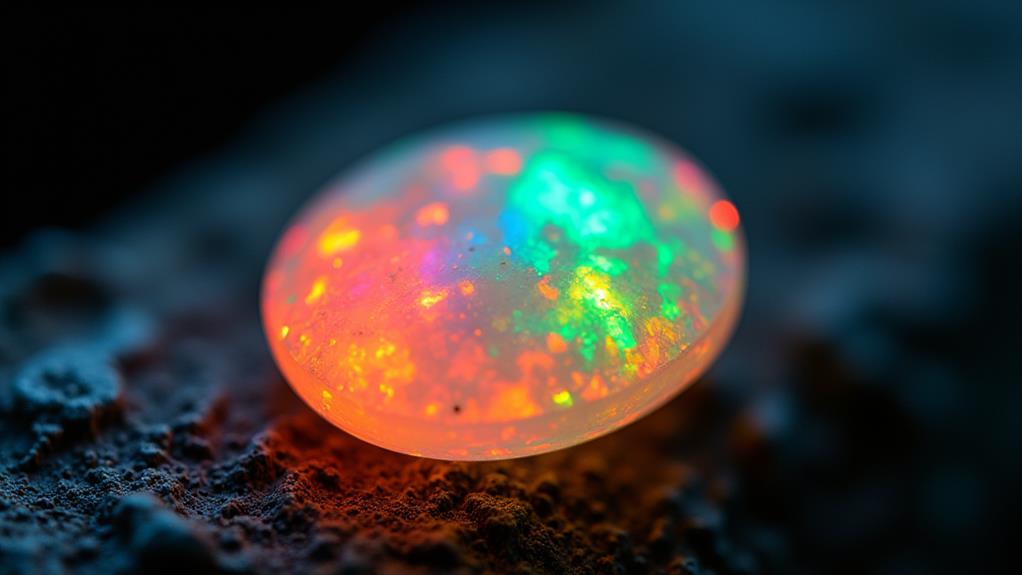
Grading opal's play-of-color incorporates evaluating factors such as brightness, color variety, pattern, and transparency, with high-value types like dark opals and crystal opals commanding premium prices due to their vivid color contrasts and clarity. Patterns such as harlequin are particularly prized for their rarity and distinct appearance, considerably influencing market valuation. Consequently, these high-quality opals are prominently featured in popular jewelry, enhancing their appeal and market demand.
High-Value Types and Patterns
Understanding the intricacies of opal's play-of-color involves examining several critical factors that contribute to its overall value. Opal, renowned for its play of color, exhibits a spectrum of vivid flashes that vary in brightness, pattern, and color variety. Among the most coveted are black opals, which display intense, multi-colored flashes against a dark background, enhancing their visual appeal and thereby their market value.
Patterns are pivotal in determining the opal's desirability. The "harlequin" pattern, characterized by large, distinct, and regularly arranged patches of color, is highly sought after. High-grade opals featuring this pattern are particularly prized. Another valued pattern is "pinfire," consisting of tiny, distinct dots of color. When these dots are evenly distributed, they greatly elevate the opal's aesthetic and monetary worth.
Crystal opals, known for their transparency, are more valuable than opaque varieties. Their clear structure allows for a more pronounced showcase of the play-of-color effect, contributing to their higher valuation. Ultimately, the interplay of brightness, color distribution, and pattern intricacy defines the allure and worth of these precious stones.
Valuation and Market Pricing
Evaluating the valuation and market pricing of opals hinges on a meticulous grading process that scrutinizes several critical attributes. The market value of opal varies dramatically, ranging from $10 to $6,000 per carat, influenced by factors such as weight, cut, clarity, and type. Black opals, particularly those sourced from Lightning Ridge, Australia, stand out as the rarest and most valuable, commanding prices up to $10,000 per carat for high-grade specimens.
The key determinant in the valuation of precious opals is their play-of-color, which is assessed based on brightness, color range, pattern, and orientation. This unique optical phenomenon considerably influences the market price. A vibrant and multifaceted play-of-color elevates the opal's desirability and cost, distinguishing precious opals from common opals, which lack this feature and are therefore valued considerably lower.
Authenticity verification remains paramount, as the market is rife with imitations and synthetic opals. Ensuring the authenticity of an opal not only safeguards investment but also upholds its intrinsic value. Collectors and enthusiasts must be adept at discerning these nuances to appreciate and accurately assess the market price of these enthralling gemstones.
Popular Jewelry Incorporating Opals
In the domain of fine jewelry, the allure of opals extends beyond their market valuation to their enchanting integration into various adornments. Opal jewelry, including rings, necklaces, earrings, and bracelets, is revered for the stone's vibrant play-of-color—a phenomenon where colors shift intriguingly with movement. This property makes each opal piece uniquely mesmerizing.
The grading of an opal's play-of-color hinges on several factors: brightness, color variety, pattern, and transparency. Brightness and the variety of colors present are paramount, with more vivid, diverse hues greatly elevating the opal's value. Pattern also plays a vital role; the highly coveted "rolling flash" pattern, where colors appear to move across the stone, is particularly prized. Transparency, or the stone's ability to transmit light, further influences its aesthetic and market appeal.
Precious opals exhibiting a strong, vibrant play-of-color, especially Black Opals, are highly valued due to their dark body tone that accentuates color contrast. These opals are often set in gold or sterling silver to enhance their visual appeal and protect their somewhat delicate nature. Beyond their beauty, opals are believed to possess healing properties, adding an extra layer of allure to this precious stone in jewelry settings.
Frequently Asked Questions
What Zodiac Signs Should Wear Opal?
Individuals born under the zodiac signs of Libra and Scorpio should consider wearing opal. Its color variations align with their need for emotional balance and clarity. Additionally, opal's connection to the Water element makes it beneficial for Cancer and Pisces, enhancing their intuitive traits. When selecting opal jewelry styles, prioritize proper opal care tips to maintain its beauty. Comparing opal vs. other gemstones, opal myths debunked reveal its unique allure.
What Are the Healing Properties of Opal?
Opal's healing properties encompass physical, emotional, and spiritual domains. Opal energy alleviates joint pain, muscle tension, and skin conditions, promoting overall well-being. Different Opal types harmonize emotions, boost creativity, and enhance emotional balance. Opal rituals and meditation sessions amplify thoughts, fostering mental clarity and introspection. Regular use supports the immune system and regulates insulin production, making Opal a versatile tool for holistic health and personal growth.
What Are the Benefits of Wearing Opal in Astrology?
Wearing opal in astrology offers numerous benefits, particularly for Libra and Scorpio individuals. The various opal types and opal colors resonate uniquely with personal traits, enhancing emotional balance and psychic abilities. Opal jewelry is believed to strengthen spiritual connections, providing clarity and insight. While opal myths suggest mystical properties, proper opal care is essential to maintain its efficacy and beauty, ensuring its continuous positive influence on the wearer.
What Do Opals Signify Spiritually?
Opal symbolism encompasses a rich tapestry of spiritual significances, including amplification, hope, and emotional intelligence. The inherent Opal energy is believed to ward off negativity, enhance intuition, and foster emotional transformation. Utilized in Opal meditation, this gemstone facilitates spiritual growth and balance. Additionally, each color variant aligns with specific chakras, promoting a seamless flow of spiritual energy and emotional healing, making Opal a powerful spiritual ally.
